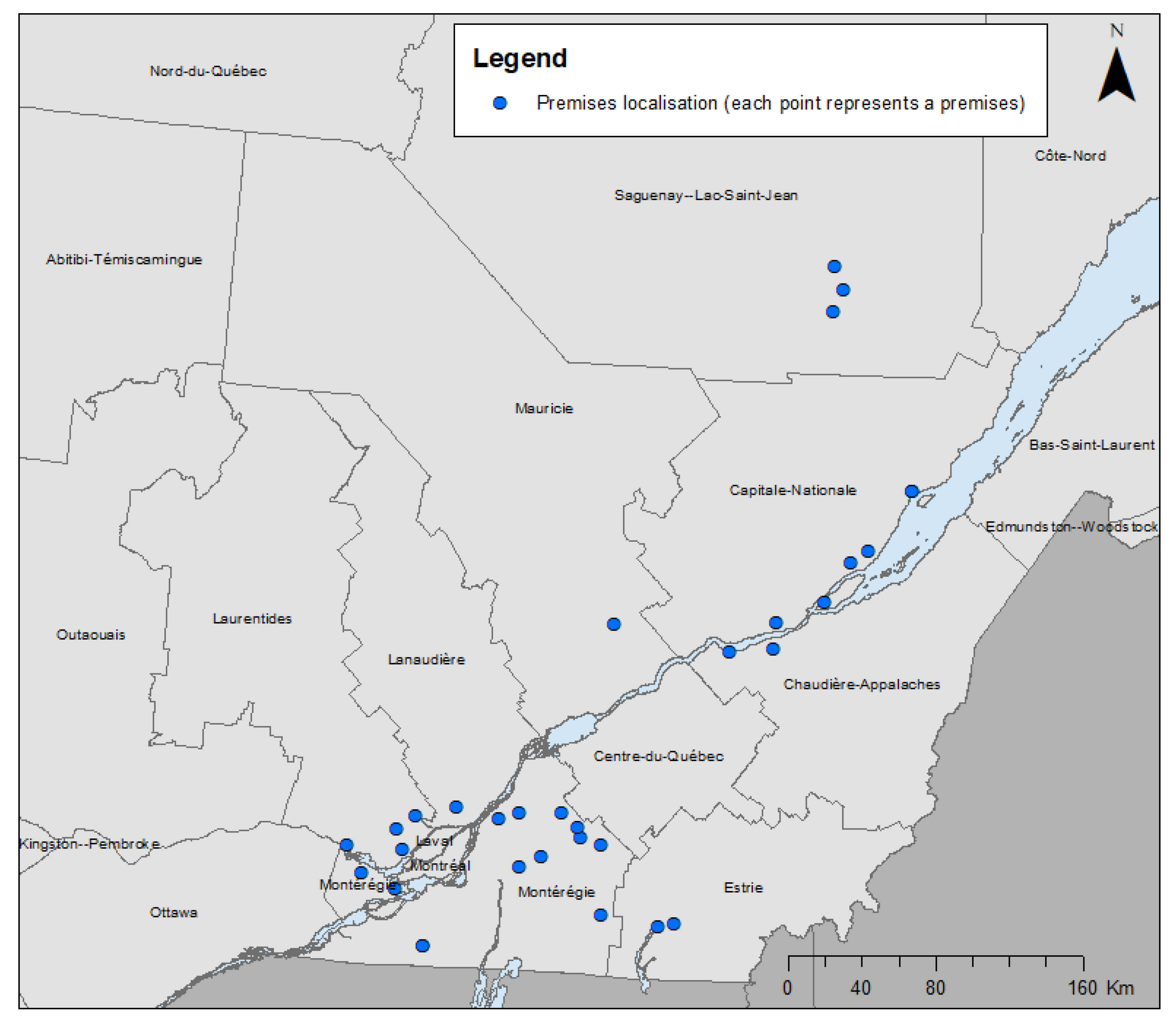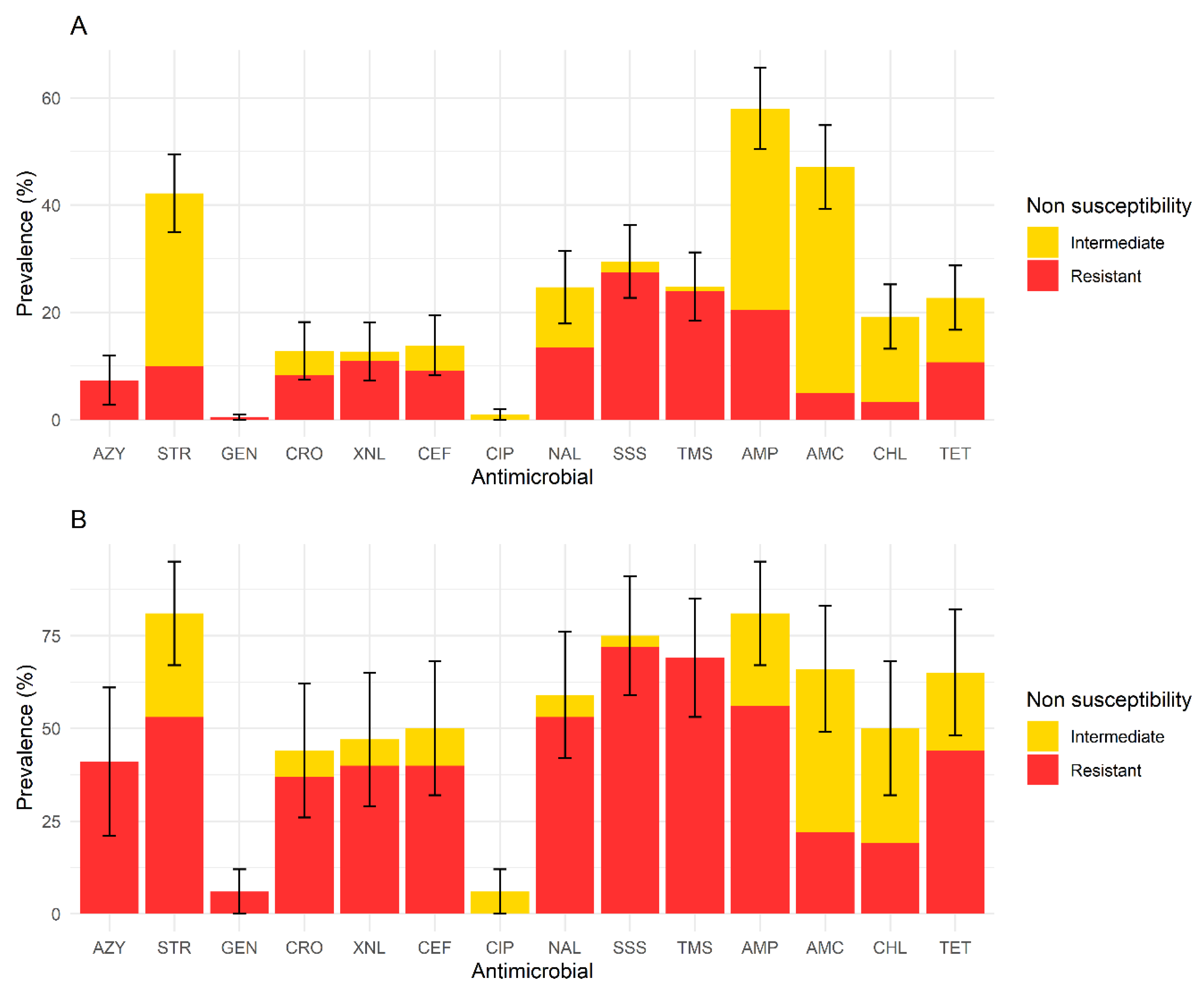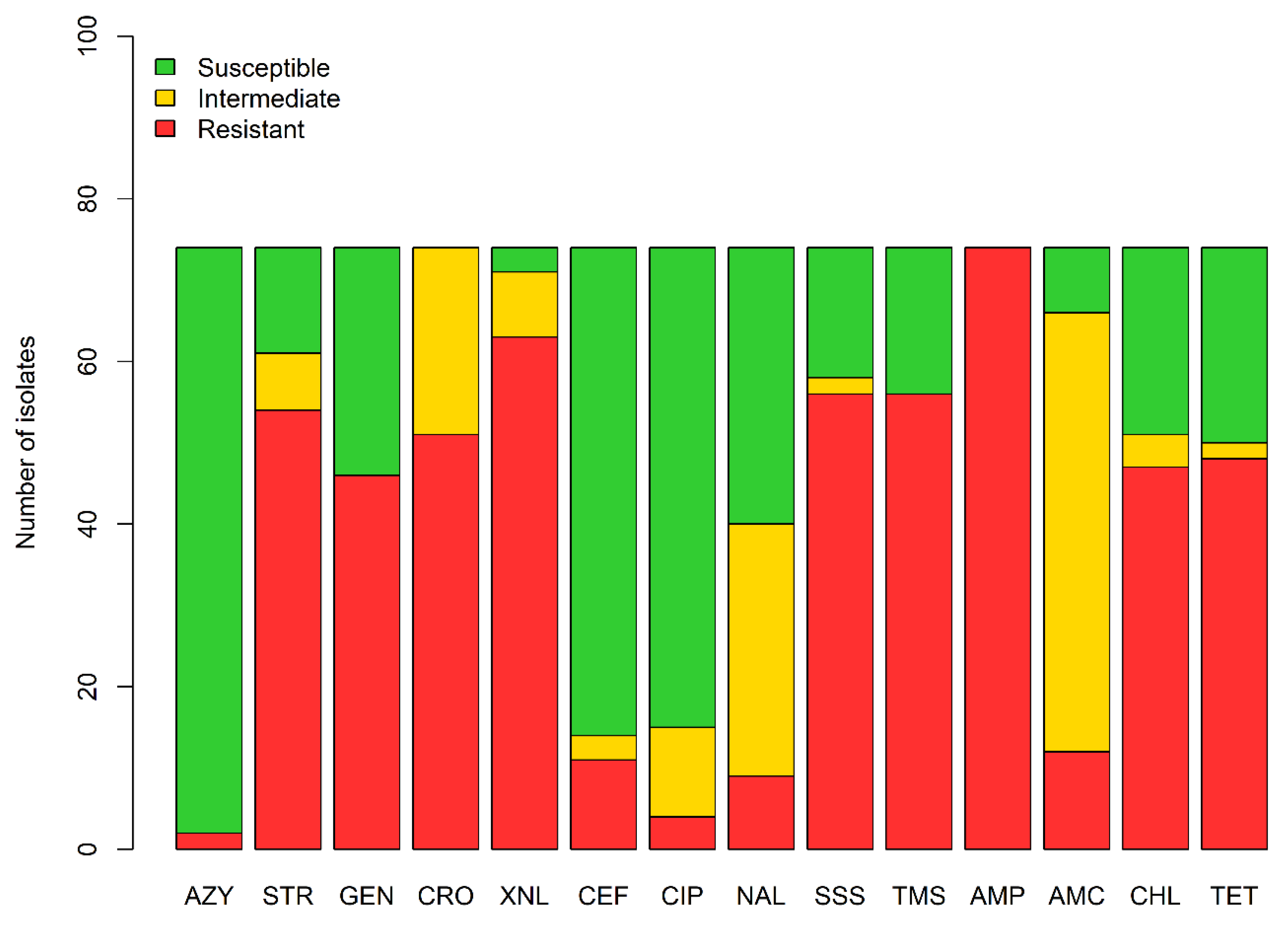Prevalence, Risk Factors, and Characterization of Multidrug Resistant and ESBL/AmpC Producing Escherichia coli in Healthy Horses in Quebec, Canada, in 2015–2016
Abstract
:Simple Summary
Abstract
1. Introduction
2. Materials and Methods
2.1. Sampling and Data Collection
2.2. Indicator Collection: Non-enriched Culture, Antimicrobial Susceptibility Testing, ESBL/AmpC Gene Identification, and Prevalence Estimation
2.3. Potential ESBL/AmpC Producing E. coli Collection: Culture, Antimicrobial Susceptibility Testing, ESBL/AmpC and Virulence Gene Identification and Descriptive Statistics
2.4. MDR and ESBL/AmpC: Risk Factors
3. Results
3.1. Indicator Collection
3.2. ESBL/AmpC Collection
3.3. Risk Factors
4. Discussion
5. Conclusions
Supplementary Materials
Author Contributions
Funding
Acknowledgments
Conflicts of Interest
References
- World Health Organization. Antimicrobial Resistance: Global Report on Surveillance; World Health Organization: Geneva, Sweden, 2014. [Google Scholar]
- Hariharan, H.; Barnum, D.A.; Mitchell, W.R. Drug resistance among pathogenic bacteria from animals in Ontario. Can. J. Comp. Med. 1974, 38, 213–221. [Google Scholar]
- van Spijk, J.; Schmitt, S.; Schoster, A. Infections caused by multidrug-resistant bacteria in an equine hospital (2012–2015). Equine Vet. Educ. 2019, 31, 653–658. [Google Scholar] [CrossRef]
- Jokisalo, J.; Bryan, J.; Legget, B.; Abbott, Y.; Katz, L. Multiple-drug resistant Acinetobacter baumannii bronchopneumonia in a colt following intensive care treatment. Equine Vet. Educ. 2010, 22, 281–286. [Google Scholar] [CrossRef]
- Giguere, S.; Berghaus, L.J.; Willingham-Lane, J.M. Antimicrobial resistance in Rhodococcus equi. Microbiol. Spectr. 2017, 5. [Google Scholar] [CrossRef]
- Maddox, T.W.; Clegg, P.D.; Diggle, P.J.; Wedley, A.L.; Dawson, S.; Pinchbeck, G.L.; Williams, N.J. Cross-sectional study of antimicrobial-resistant bacteria in horses. Part 1: Prevalence of antimicrobial-resistant Escherichia coli and methicillin-resistant Staphylococcus aureus. Equine Vet. J. 2012, 44, 289–296. [Google Scholar] [CrossRef] [PubMed]
- de Lagarde, M.; Larrieu, C.; Praud, K.; Schouler, C.; Doublet, B.; Salle, G.; Fairbrother, J.M.; Arsenault, J. Prevalence, risk factors, and characterization of multidrug resistant and extended spectrum beta-lactamase/AmpC beta-lactamase producing Escherichia coli in healthy horses in France in 2015. J. Vet. Intern. Med. 2019, 33, 902–911. [Google Scholar] [CrossRef] [PubMed] [Green Version]
- Aarestrup, F.M.; Hasman, H.; Veldman, K.; Mevius, D. Evaluation of eight different cephalosporins for detection of cephalosporin resistance in Salmonella enterica and Escherichia coli. Microb. Drug Resist. 2010, 16, 253–261. [Google Scholar] [CrossRef]
- Maddox, T.W.; Clegg, P.D.; Williams, N.J.; Pinchbeck, G.L. Antimicrobial resistance in bacteria from horses: Epidemiology of antimicrobial resistance. Equine Vet. J. 2015, 47, 756–765. [Google Scholar] [CrossRef] [Green Version]
- DebRoy, C.; Roberts, E.; Jayarao, B.M.; Brooks, J.W. Bronchopneumonia associated with extraintestinal pathogenic Escherichia coli in a horse. J. Vet. Diagn. Investig. 2008, 20, 661–664. [Google Scholar] [CrossRef] [Green Version]
- Government of Canada. Canadian Antimicrobial Resistance Surveillance Systeme—Report; Public Health Agency: Ottawa, ON, Canada, 2016. Available online: http://publications.gc.ca/pub?id=9.512584&sl=1 (accessed on 1 September 2016).
- Rubin, J.E.; Pitout, J.D. Extended-spectrum beta-lactamase, carbapenemase and AmpC producing Enterobacteriaceae in companion animals. Vet. Microbiol. 2014, 170, 10–18. [Google Scholar] [CrossRef]
- Johns, I.C.; Adams, E.L. Trends in antimicrobial resistance in equine bacterial isolates: 1999–2012. Vet. Rec. 2015, 176, 334. [Google Scholar] [CrossRef] [PubMed]
- Ewers, C.; Bethe, A.; Semmler, T.; Guenther, S.; Wieler, L.H. Extended-spectrum beta-lactamase-producing and AmpC-producing Escherichia coli from livestock and companion animals, and their putative impact on public health: A global perspective. Clin. Microbiol. Infect. 2012, 18, 646–655. [Google Scholar] [CrossRef] [PubMed] [Green Version]
- Cantón, R.; González-Alba, J.; Galán, J. CTX-M enzymes: Origin and diffusion. Front. Microbiol. 2012, 3, 110. [Google Scholar] [CrossRef] [PubMed] [Green Version]
- Carattoli, A. Plasmids in Gram negatives: Molecular typing of resistance plasmids. Int. J. Med. Microbiol. 2011, 301, 654–658. [Google Scholar] [CrossRef]
- Mathers, A.J.; Peirano, G.; Pitout, J.D. The role of epidemic resistance plasmids and international high-risk clones in the spread of multidrug-resistant Enterobacteriaceae. Clin. Microbiol. Rev. 2015, 28, 565–591. [Google Scholar] [CrossRef] [Green Version]
- Roer, L.; Overballe-Petersen, S.; Hansen, F.; Schonning, K.; Wang, M.; Roder, B.L.; Hansen, D.S.; Justesen, U.S.; Andersen, L.P.; Fulgsang-Damgaard, D.; et al. Escherichia coli sequence type 410 is causing new international high-risk clones. mSphere 2018, 3, e00337-18. [Google Scholar] [CrossRef] [Green Version]
- Huijbers, P.M.; de Kraker, M.; Graat, E.A.; van Hoek, A.H.; van Santen, M.G.; de Jong, M.C.; van Duijkeren, E.; de Greeff, S.C. Prevalence of extended-spectrum beta-lactamase-producing Enterobacteriaceae in humans living in municipalities with high and low broiler density. Clin. Microbiol. Infect. 2013, 19, E256–E259. [Google Scholar] [CrossRef] [Green Version]
- Barbier, F.; Pommier, C.; Essaied, W.; Garrouste-Orgeas, M.; Schwebel, C.; Ruckly, S.; Dumenil, A.-S.; Lemiale, V.; Mourvillier, B.; Clec’h, C.; et al. Colonization and infection with extended-spectrum β-lactamase-producing Enterobacteriaceae in ICU patients: What impact on outcomes and carbapenem exposure? J. Antimicrob. Chemother. 2016, 71, 1088–1097. [Google Scholar] [CrossRef] [Green Version]
- Health Canada. Categorization of Antimicrobial Drugs Based on Importance in Human Medicine. 2019. Available online: https://www.canada.ca/en/health-canada/services/drugs-health-products/veterinary-drugs/antimicrobial-resistance/categorization-antimicrobial-drugs-based-importance-human-medicine.html (accessed on 1 April 2009).
- World Health Organization. Critically Important Antimicrobials for Human medicine: Ranking of Antimicrobial Agents for Risk Management of Antimicrobial Resistance due to Non-Human Use; World Health Organization: Geneva, Sweden, 2017. [Google Scholar]
- Gouvernment of Quebec. Decret 1110–2018. Loi sur la protection des animaux (chapitre P-42). In Administration de Certains Médicaments-Modification; Editeur Officiel du Quebec: Quebec, QC, Canada, 2019. [Google Scholar]
- Maddox, T.W.; Pinchbeck, G.L.; Clegg, P.D.; Wedley, A.L.; Dawson, S.; Williams, N.J. Cross-sectional study of antimicrobial-resistant bacteria in horses. Part 2: Risk factors for faecal carriage of antimicrobial-resistant Escherichia coli in horses. Equine Vet. J. 2012, 44, 297–303. [Google Scholar] [CrossRef]
- Martins, M.T.; Rivera, I.G.; Clark, D.L.; Stewart, M.H.; Wolfe, R.L.; Olson, B.H. Distribution of uidA gene sequences in Escherichia coli isolates in water sources and comparison with the expression of beta-glucuronidase activity in 4-methylumbelliferyl-beta-D-glucuronide media. Appl. Environ. Microbiol. 1993, 59, 2271–2276. [Google Scholar] [CrossRef] [Green Version]
- Magiorakos, A.P.; Srinivasan, A.; Carey, R.B.; Carmeli, Y.; Falagas, M.E.; Giske, C.G.; Harbarth, S.; Hindler, J.F.; Kahlmeter, G.; Olsson-Liljequist, B.; et al. Multidrug-resistant, extensively drug-resistant and pandrug-resistant bacteria: An international expert proposal for interim standard definitions for acquired resistance. Clin. Microbiol. Infect. 2012, 18, 268–281. [Google Scholar] [CrossRef] [PubMed] [Green Version]
- Agerso, Y.; Aarestrup, F.M.; Pedersen, K.; Seyfarth, A.M.; Struve, T.; Hasman, H. Prevalence of extended-spectrum cephalosporinase (ESC)-producing Escherichia coli in Danish slaughter pigs and retail meat identified by selective enrichment and association with cephalosporin usage. J. Antimicrob. Chemother. 2012, 67, 582–588. [Google Scholar] [CrossRef] [PubMed] [Green Version]
- Giguère, S.; Prescott, J.F.; Dowling, P.M. Antimicrobial Therapy in Veterinary Medicine; John Wiley & Sons: New York, NY, USA, 2013. [Google Scholar]
- Murphy, C.; Reid-Smith, R.J.; Prescott, J.F.; Bonnett, B.N.; Poppe, C.; Boerlin, P.; Weese, J.S.; Janecko, N.; McEwen, S.A. Occurrence of antimicrobial resistant bacteria in healthy dogs and cats presented to private veterinary hospitals in southern Ontario: A preliminary study. Can. Vet. J. 2009, 50, 1047–1053. [Google Scholar] [PubMed]
- Zhang, P.L.C.; Shen, X.; Chalmers, G.; Reid-Smith, R.J.; Slavic, D.; Dick, H.; Boerlin, P. Prevalence and mechanisms of extended-spectrum cephalosporin resistance in clinical and fecal Enterobacteriaceae isolates from dogs in Ontario, Canada. Vet. Microbiol. 2018, 213, 82–88. [Google Scholar] [CrossRef] [PubMed]
- Timonin, M.E.; Poissant, J.; McLoughlin, P.D.; Hedlin, C.E.; Rubin, J.E. A survey of the antimicrobial susceptibility of Escherichia coli isolated from Sable Island horses. Can. J. Microbiol. 2017, 63, 246–251. [Google Scholar] [CrossRef]
- Jahanbakhsh, S.; Letellier, A.; Fairbrother, J.M. Circulating of CMY-2 beta-lactamase gene in weaned pigs and their environment in a commercial farm and the effect of feed supplementation with a clay mineral. J. Appl. Microbiol. 2016, 121, 136–148. [Google Scholar] [CrossRef] [Green Version]
- Verrette, L.; Fairbrother, J.M.; Boulianne, M. Effect of cessation of ceftiofur and substitution with lincomycin-spectinomycin on extended-spectrum-beta-lactamase/AmpC genes and multidrug resistance in Escherichia coli from a Canadian broiler production pyramid. Appl. Environ. Microbiol. 2019, 85, e00037-19. [Google Scholar] [CrossRef] [Green Version]
- Allen, K.J.; Poppe, C. Occurrence and characterization of resistance to extended-spectrum cephalosporins mediated by beta-lactamase CMY-2 in Salmonella isolated from food-producing animals in Canada. Can. J. Vet. Res. 2002, 66, 137–144. [Google Scholar]
- Peirano, G.; Costello, M.; Pitout, J.D. Molecular characteristics of extended-spectrum beta-lactamase-producing Escherichia coli from the Chicago area: high prevalence of ST131 producing CTX-M-15 in community hospitals. Int. J. Antimicrob. Agents 2010, 36, 19–23. [Google Scholar] [CrossRef]
- WHO (World Health Organisation). One Health. 2017. Available online: https://www.who.int/features/qa/one-health/en/ (accessed on 1 February 2017).
- Jacoby, G.A. Mechanisms of resistance to quinolones. Clin. Infect. Dis. 2005, 41 (Suppl. 2), S120–S126. [Google Scholar] [CrossRef] [Green Version]
- Robert, J.; Cambau, E.; Grenet, K.; Trystram, D.; Pean, Y.; Fievet, M.H.; Jarlier, V. Trends in quinolone susceptibility of Enterobacteriaceae among inpatients of a large university hospital: 1992–1998. Clin. Microbiol. Infect. 2001, 7, 553–561. [Google Scholar] [CrossRef] [PubMed] [Green Version]
- Aslam, M.; Checkley, S.; Avery, B.; Chalmers, G.; Bohaychuk, V.; Gensler, G.; Reid-Smith, R.; Boerlin, P. Phenotypic and genetic characterization of antimicrobial resistance in Salmonella serovars isolated from retail meats in Alberta, Canada. Food Microbiol. 2012, 32, 110–117. [Google Scholar] [CrossRef] [PubMed]



| Number of Resistant Antimicrobial Classes | Indicator Collection | |||
|---|---|---|---|---|
| Horse Level (n = 209) | Premises Level (n = 32) | |||
| % | 95% CI | % | 95% CI | |
| ≥1 | 80.0 | 69.8–90.2 | 96.9 | 90.5–100 |
| ≥3 (MDR) | 46.3 | 34.5–58.0 | 81.3 | 67.0–95.5 |
| ≥5 | 15.3 | 8.5–22.3 | 53.1 | 34.8–71.4 |
| ≥7 | 3.9 | 1.5–6.2 | 25.0 | 9.1–40.9 |
| ≥9 | 1.4 | 0–3.2 | 9.4 | 0–20.1 |
| Putative Risk Factors | Number of Horses | % of MDR-Positive Horses | p-Value | |
|---|---|---|---|---|
| Horse-level | ||||
| Transportation out of the horse’s premises within the last 3 months | 0.11 | |||
| Yes | 31 | 41.9 | ||
| No | 69 | 29.0 | ||
| Participation to an equestrian event within the last 3 months | 0.13 | |||
| - | Yes | 19 | 57.9 | |
| - | No | 92 | 29.3 | |
| Housing | 0.28 | |||
| - | Stable | 46 | 39.1 | |
| - | Pasture 1 | 64 | 29.7 | |
| Activity | 0.73 | |||
| - | Sport (competition) | 39 | 43.6 | |
| - | Leisure | 66 | 30.3 | |
| - | Reproduction | 4 | 25.0 | |
| The horse presents a chronic disease | 0.47 | |||
| - | Yes | 18 | 22.2 | |
| - | No | 123 | 39.0 | |
| The horse presented an infection (diagnosed by the veterinarian) within the last 3 months | 0.03 | |||
| - | Yes | 12 | 75.0 | |
| - | No | 124 | 34.7 | |
| The horse presented diarrhea within the last 3 months | 0.91 | |||
| - | Yes | 5 | 20.0 | |
| - | No | 61 | 23.0 | |
| The horse was hospitalized within the last 3 months | The model did not converge | |||
| - | Yes | 2 | 100 | |
| - | No | 137 | 37.2 | |
| The horse has undergone surgery within the last 3 months | The model did not converge | |||
| - | Yes | 1 | 100 | |
| - | No | 137 | 38.0 | |
| The horse has been medically treated within the last three months (all treatment considered) | 0.02 | |||
| - | Yes | 39 | 53.9 | |
| - | No | 94 | 30.9 | |
| The horse presented with colic within the last 3 months | 0.81 | |||
| - | Yes | 5 | 40 | |
| - | No | 131 | 37.4 | |
| Premise-level | ||||
| Total number of horses in the premises 2 | 0.26 | |||
| - | Less than 15 | 101 | 45.5 | |
| - | 15 and more | 109 | 48.6 | |
| Number of staff taking care of horses daily 3 | 0.01 | |||
| - | Less than 5 persons | 68 | 23.5 | |
| - | 5 persons and more | 38 | 47.4 | |
| Risk Factor for the Outcome | Odds Ratios | ||
|---|---|---|---|
| Estimate | 95% CI | p | |
| The horse has participated in an equestrian event within the last three months (yes vs. no) | 3.5 | 1.1, 11.1 | 0.03 |
| Number of staff taking care of horses daily (5 persons and more vs. less than 5 persons) | 3.4 | 1.3, 8.7 | 0.01 |
© 2020 by the authors. Licensee MDPI, Basel, Switzerland. This article is an open access article distributed under the terms and conditions of the Creative Commons Attribution (CC BY) license (http://creativecommons.org/licenses/by/4.0/).
Share and Cite
de Lagarde, M.; Fairbrother, J.M.; Arsenault, J. Prevalence, Risk Factors, and Characterization of Multidrug Resistant and ESBL/AmpC Producing Escherichia coli in Healthy Horses in Quebec, Canada, in 2015–2016. Animals 2020, 10, 523. https://doi.org/10.3390/ani10030523
de Lagarde M, Fairbrother JM, Arsenault J. Prevalence, Risk Factors, and Characterization of Multidrug Resistant and ESBL/AmpC Producing Escherichia coli in Healthy Horses in Quebec, Canada, in 2015–2016. Animals. 2020; 10(3):523. https://doi.org/10.3390/ani10030523
Chicago/Turabian Stylede Lagarde, Maud, John M. Fairbrother, and Julie Arsenault. 2020. "Prevalence, Risk Factors, and Characterization of Multidrug Resistant and ESBL/AmpC Producing Escherichia coli in Healthy Horses in Quebec, Canada, in 2015–2016" Animals 10, no. 3: 523. https://doi.org/10.3390/ani10030523
APA Stylede Lagarde, M., Fairbrother, J. M., & Arsenault, J. (2020). Prevalence, Risk Factors, and Characterization of Multidrug Resistant and ESBL/AmpC Producing Escherichia coli in Healthy Horses in Quebec, Canada, in 2015–2016. Animals, 10(3), 523. https://doi.org/10.3390/ani10030523






